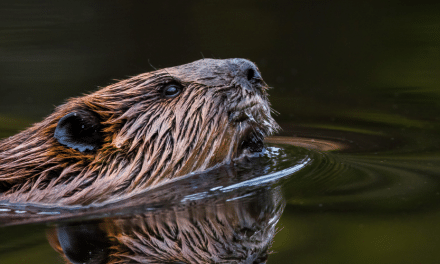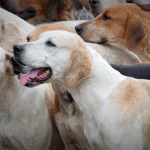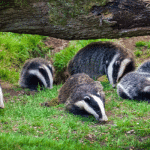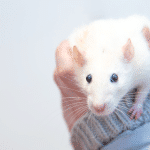By Luke Steele, Masters student at the University of Bradford, Managing Director and Spokesperson of Ban Bloodsports on Yorkshire’s Moors
At first glance, the Hen Harrier Recovery Plan (DEFRA, 2016) looks positive: a protection scheme for at-risk hen harriers that looks to give one of England’s rarest birds of prey a renewed foothold in the uplands. However, this brood management project may do more harm than good, even though Natural England, the government’s habitats regulator, has been clear that it wants to end the illegal killing of hen harriers on grouse moors.
Grouse moors need to attain large numbers of naturally occuring game birds to be commercially viable, and they often achieve this through eradication of natural predators, including, historically, hen harriers. Some have seen numbers reach 200-500 grouse per square kilometer, approximately 100 times the natural density. Without destroying predators to artificially create optimal breeding conditions, the moors would not reach such numbers and would not be commercially viable.
Research shows that breeding hen harriers can threaten the viability of grouse moors because these airborne predators eat grouse chicks for survival. The aim of brood management is to remove hen harrier chicks from grouse moors once breeding numbers have reached a density which would impact grouse stocks.
Grouse moors are required by Natural England to maintain at least one hen harrier nest on their land if they are participating in the scheme. In doing so, they are expected to tolerate a degree of predation on grouse stocks by resisting persecution. This mirrors abatement schemes, more commonly agreed between regulators and polluters, which seek to lower ecologically harmful practices. If a participating grouse moor finds that hen harriers have formed a second nest within 10 kilometers of the first, the regulator will reward the moor for complying with the scheme by removing that second nest. Chicks will be removed by licenced individuals, raised in captivity, and then released onto donor moors once fledged. This intervention will theoretically be repeated until such a point as every grouse moor that can support hen harriers has at least one occupied nest . This appear may appear to be well considered, but in practice it means that Natural England will be appeasing an industry that has demonstrated repeatedly that is incapable of self-regulation. Hen harriers will only recover in the absence of persecution, yet this sort of brood management normalises the removal of birds of prey to protect grouse shooting. So, in effect, the regulation rewards offenders and intended beneficiaries of wrongdoing with the outcome they have always
desired. Moreover, it does little to foster acceptance among grouse moors of the importance of protecting wildlife is right. Unsurprisingly, all five of the hen harriers brood-managed during 2019 have disappeared under suspicious circumstances. And this is not a new phenomenon: In 2013, the National Wildlife Crime Unit briefed law enforcement agencies that “intelligence continues to indicate a strong association between raptor persecution and grouse moor management”. Subsequently, Natural England’s own research, which analysed a decade of hen harrier satellite-tagging data, demonstrated that hen harriers are 10 times more likely to die over English grouse moors than any other habitat.
Too many moorlands have become grouse shooting theme parks that actively unsettle the natural balance between predators and prey. For Natural England to tackle this problem, they should convert the moors’ current incentive to commit wildlife crime into an incentive for conserving birds of prey: by removing the ability of grouse moors suspected of raptor persecution to operate. Pressure is building for England and Wales to follow Scotland’s commitment to introduce mandatory licensing of grouse moors. This and other changes to the current scheme could significantly reform the country’s ecologically restrictive grouse moors and restore natural wildlife in the uplands.
Sources
Baines, D., Newborn, D., and Richardson, M. (2014), Spread of Cryptosporidium baileyi in red grouse Lagopus lagopus scoticus. Veterinary Record 175:149.
Becker, G. S. (1968). Crime and punishment: An economic approach. Journal of Political Economy, 76, 169–217
Braithwaite, J. (1987). Private Policing: Self-regulation and the control of corporate crime. Criminal Justice System Overalls. Volume 23.
DEFRA. (2016). Joint action plan to increase the English hen harrier population. [Online]. Available at: https://assets.publishing.service.gov.uk/government/uploads/system/uploads/attachment_data/file/491818/hen-harrier-action-plan-england-2016.pdf [Accessed 29/07/2020]
Etheridge, RW. (1997). The Effects of Illegal Killing and Destruction of Nests by Humans on the Population Dynamics of Hen Harrier in Scotland. Journal of Applied Ecology. Vol. 34, No 4 (Aug., 1997), pp. 1081-1105.
Langholm Moor Demonstration Project. (2014). The Langholm Moor Demonstration Project – A Seven Year Review. [Online]. Available at: www.langholmproject.com/PDF%20downloads/Langholm%20Moor%20Demonstration%20Project%20Final%20Report.pdf [Accessed 29/07/2020]
Murgatroyd, M. (2019). Patterns of satellite tagged hen harrier disappearances suggest widespread illegal killing on British grouse moors. Nature communications. 10, Article number: 1094 (2019).
Natural England. (2020). Hen harrier brood management licence renewed. [Online]. Available at: https://naturalengland.blog.gov.uk/2020/05/22/hen-harrier-brood-management-trial-licence-renewed/ [Accessed 29/07/2020]
Natural England. (2020b). Freedom Of Information request published on 8 June 2020.
Natural England. (2017). Hen harrier brood management criteria. [Online]. Available at: https://assets.publishing.service.gov.uk/government/uploads/system/uploads/attachment_data/file/674604/ne-hen-harrier-2017-28602-sci-sci-applicant-info-2.pdf [Accessed 25/04/2020].
National Wildlife Crime Unit. (2013). Strategic assessment. [Online]. Available at: www.nwcu.police.uk/ wp-content/uploads/2014/04/NWCU-Strategic-Assessment-2013-final-v2.pdf [Accessed 25/04/2020]
Thompson, P.S., Douglas, D.J.T., Hoccom, D.G., Knott, J., Roos, S., and Wilson, J.D. (2016). Environmental impacts of high-output driven shooting of Red Grouse Lagopus lagopus scotica. Ibis (2016), 158, 446–452
Tyler, TR. (1990). Why People Obey The Law. New Haven, Conn.: Yale University Press.
Werrity, A. (2019). Grouse Moor Management Review Group – Report to the Scottish Government. [Online]. Available at: www.gov.scot/publications/grouse-moor-management-group-report-scottish-government/ [Accessed 29/07/2020]


















